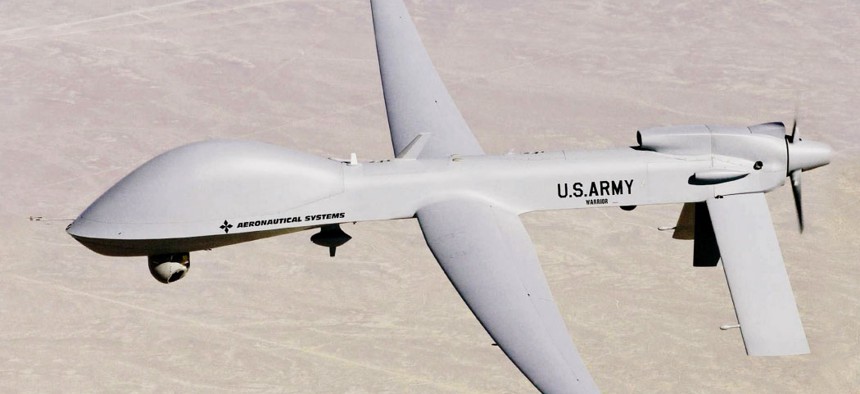Army developing a universal control for all of its drones
The TOGA system will reduce the number of pilots required while better integrating ISR with its tactical network.
The Army is working on developing the equivalent of a universal remote for its unmanned aerial systems, which would allow pilots to control more than one type of UAS while reducing the amount of training required.
The service is planning to combine the interfaces for its primary ISR (intelligence, surveillance and reconnaissance) platforms, the Gray Eagle and Shadow UAS, as well as incorporate other small UAS into the system.
"Probably one of the biggest and most impacting changes that we're looking forward to in our strategy is that of a universal operator and a universal control interface," Col. Paul Cravey, Training and Doctrine Command capability manager for UAS, said in a release.
Army UAS pilots currently train on either the Gray Eagle or Shadow, which are, respectively, medium-range and short-range platforms. It also employs smaller, low-altitude systems, such as the hand-launched Raven and Puma.
By moving to what it calls the Tactical Open Government Architecture, of TOGA, the Army is planning to reduce the number of UAS pilots required while giving them the ability to operate both Gray Eagles and Shadows, as well as any small UAS in their airspace.
The system could help solve the shortage of drone pilots, something the military has been wrestling with, while also allowing unified control, which has been another goal.
"Once qualified on that universal interface, they then can control the assets that are apportioned to the brigade combat team or the ground commander who is being supported in that environment," Cravey said at a recent forum. He said the TOGA interface will be modular and scalable, so that it could be installed in a tactical operations center, a permanent base, a tactical vehicle or an Apache helicopter. (Giving Apache pilots control of Gray Eagles is something the Army has been making progress on.)
"We're working the interface, building both a government-developed option that works on current materiel while considering alternatives that might be tailorable off-the-shelf to our current products,” Cravey said.
The Army expects to field TOGA within a few years, which will coincide with plans to field what’s called the Improved Gray Eagle, a larger version of the UAS with an extended range. The Improved Gray Eagle is expected to be deployed in 2018.
The goal is not only to integrate UAS control but to more seamlessly tie their ISR data into the Army’s tactical network. "TOGA is something that will allow us the opportunity to integrate smaller UAS and control it and also put that on the soldier and help define some of the boundaries between us like Net Warrior and some soldier-born sensor things that are evolving now at the Maneuver Center," said Col. Courtney Cote, project manager for UAS, Program Executive Officer Aviation.
NEXT STORY: ULA's Air Force launch contract under scrutiny





